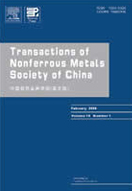Pulse electroforming of nickel under perturbation of hard particles
(College of Mechanical and Electrical Engineering, Nanjing University of Aeronautics and Astronautics, Nanjing 210016, China)
Abstract: Nickel deposits were prepared by pulse electroforming, in which an aluminium alloy cylinder mandrel rotated in hard particles filling between the electrodes. The microstructure and properties of the deposits were studied by contrasting with electroforming using direct current. The results show that the surface of the deposits obtained by pulse electroforming displays more obvious abrasion marks and (200) preferred orientation to that electroformed using direct current at the same average current density. Besides, the deposits represent higher microhardness and better high-temperature corrosion resistance. It is also found that the orientation index of plane (200) and microhardness significantly increase with the reduction of duty cycle of pulse current. During pulse electroforming, the longer off-time and higher peak current density are helpful to strengthening the hard particles’ polishing effect on the surface of deposits and perturbing effect on crystal nucleation of atoms.
Key words: nickel; electroforming; electrodeposition; pulse; hard particle; property; microstructure

